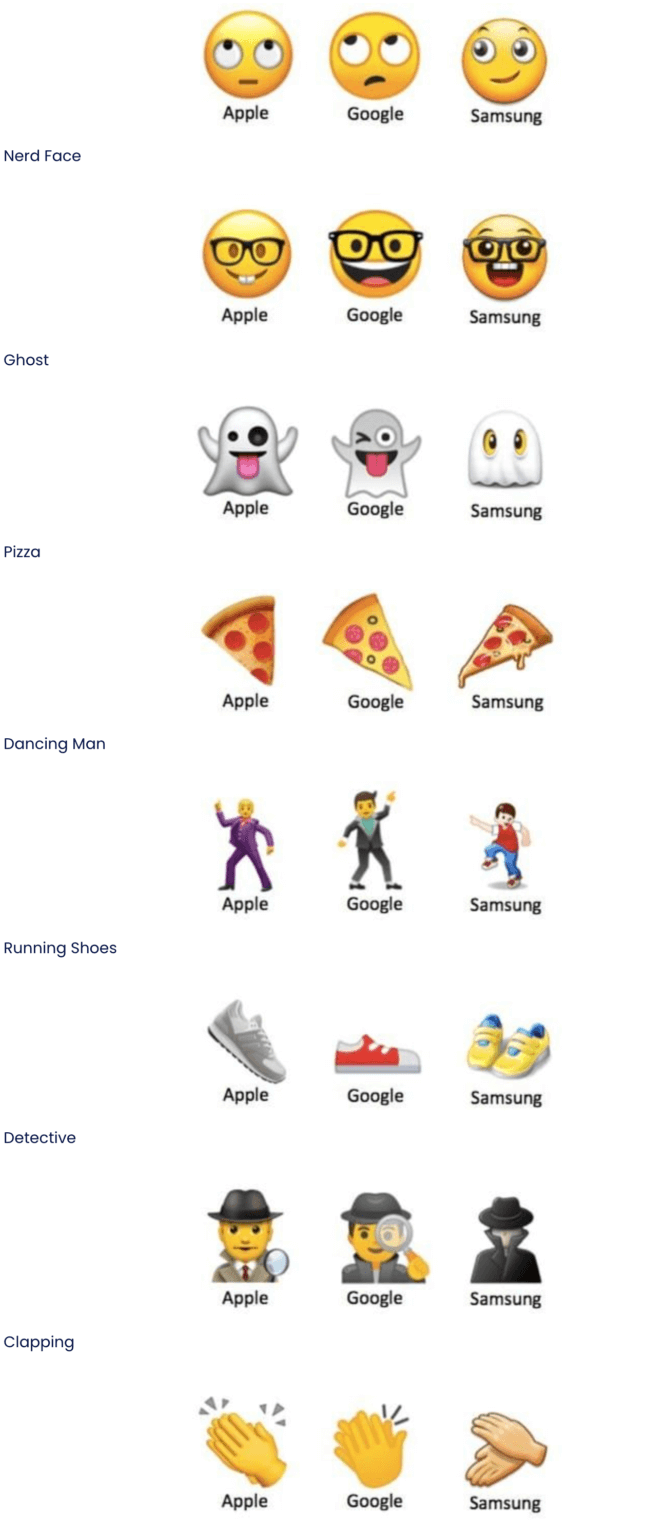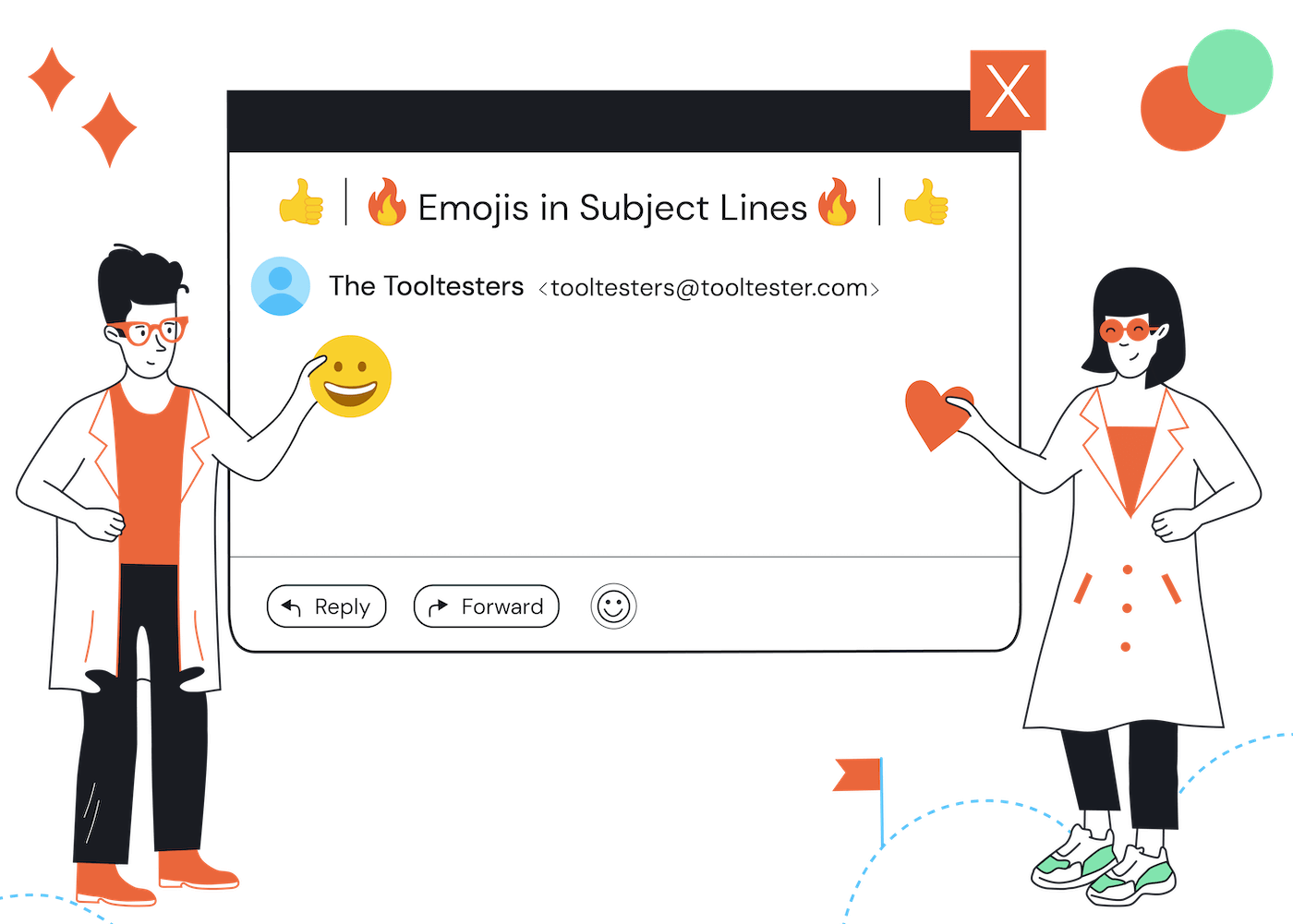As an email marketer, you will hear many supposed advantages of using emojis in email subject lines. These include:
- Standing out in a crowded inbox
- Increasing engagement.
- Reinforcing your message’s meaning
- Boosting your brand identity
- Saving space (for better visibility)
However, there are just as many quantitative studies that contradict these assumptions, as there are those that support them.
So what's the deal? Are emojis in email subject lines good, or bad for business?
I’ve analyzed all the research studies on the use of emojis in email subject lines to help you decide. And at the end of this article you’ll also find recommendations for best practices if you do use emojis in your subject lines.
Conflicting Studies on Emojis in Email Subject Lines
If you're thinking about using emojis in subject lines, you'll find research to support whatever decision you make.
Such studies include work by:
- Nielsen Norman (NN) Group
- Journal of Research for Interactive Marketing (JRIM)
- Search Engine Journal (SEJ)
- Return Path
Let’s go through the most important ways that emojis in subject lines could affect your campaigns and see what each study had to say.
Consideration & Visibility
The most popular argument for using emojis in email subject lines is that they attract attention. In a crowded inbox of text-only subject lines, they'll stand out and be more visible to contacts.
Well, what does research say?
The Nielsen Norman (NN) Group research study found that people are more likely to consider an email subject line with an emoji. 33% of participants in the study were attracted to emoji subject lines, compared to 9% who chose non-emoji subject lines.
But consideration is no good if the recipient doesn’t respond well when they notice the emoji.
And the same study found that people are 26% more likely to have a negative reaction to emails with emojis in the subject line. Participants used more negative words, like “annoying” and “dull”, to describe emoji subject lines. They also rated and perceived the emails as less valuable than non-emoji subject lines.
They were asked to select 2 emails that captured their attention and that they would open, and it was reported that “adding an emoji to an email subject line doesn't make people more likely to want to open the email.”
This means that, although using emojis in subject lines provides visibility, email subscribers might consider, but not engage with the emails. However, this study was about perception and intention.
It didn’t analyze what people actually do in real life!
So, let's see what studies that analyzed real world behavior have to say about the real world engagement rate of emails with emojis in the subject lines.
Engagement Rate (Open & Click-Through Rate)
Yes, emoji subject lines will probably stand out in a crowded inbox of plain text subject lines.
But, does that mean that emojis will increase your engagement rate? Will subscribers open your email and click through because of the emoji in the subject line?
According to this research paper in the Journal of Research for Interactive Marketing (JRIM), the presence of emojis in emails encourages customer engagement. In fact, results showed an increase in the number of opens and click-throughs for emails with emojis.
However, a study by Search Engine Journal (SEJ), in which 3.9 million emails with emojis and non-emoji subject lines were analyzed, had a contrasting result.
This study reported that non-emoji email subject lines had a higher open rate than those with emojis (53.94% to 47.06%). However, this difference isn't much. And, considering that emoji subject lines actually had a higher click-through rate in 11 out of 15 of the tests, then it might seem a worthwhile trade-off!
Unsubscribes & spam reports
It wouldn't be far-fetched to think that subscribers who consider emoji email subject lines as boring and less valuable, would unsubscribe or report the emails as spam.
28% of participants in the NN Group study said email subject lines with emojis were “dull” and 25% said they were “boring”. When people find something boring or dull, they may view the email as spam, and hit the unsubscribe or report spam button.
This assertion is validated by the SEJ study, which indicated that emails with emojis in the headline had a higher unsubscribe rate. Furthermore, these emails had more abuse complaints, with 7 out of 10 campaigns with emojis in the subject lines having more abuse reports than campaigns with non-emoji subject lines.
Position in the subject line
Before looking at the research studies, I had assumed that placing an emoji on the left (the beginning of the subject line) was best.
I thought they would generate curiosity. Besides, they may be cut off when placed to the right (at the end of the subject line).
Well, the research paints a different picture.
The JRIM research studied the effect of the position of emojis on customer engagement. And, it found that placing the emoji on the left (before the text) had a stronger negative effect than when placed last on the right.
This finding is supported by the SEJ study, which found that 7 out of 12 campaigns (58.3%) had a better open rate with the emoji placed at the end of the subject line.
Due to some email clients not displaying the full subject line, especially on mobile devices, the fact that it gets cut off may actually be responsible for the improved performance.
Faces vs Objects
Since the position of the emoji in the subject line matters, you might think that the type of emojis in email subject lines matters, too. The question is, “are face emojis preferred to objects, or vice versa?
The JRIM study found that object emojis have a stronger impact on subscribers’ engagement than facial emojis. This is especially apparent when the object emojis used are related to the subject line text and the context of the email content.
An additional study by Return Path had similar findings: the lip 💋 emoji when used in Valentine's Day promos had a higher read rate (24%) than the kiss 😘 and blush 😊 emojis (22% each).
Likewise, for Father's Day promos, the tool 🔧 and shirt 👔 emoji had a higher read rate (22%) than the man 👨🏾 emoji (19%).
So, what does all this mean?
Well, it doesn't mean you should never use emojis in your email subject lines. Instead, you should be aware of why, when, and how you shouldn’t use them. The key is to proceed with caution…
Best Practices for Using Emojis in Subject Lines
Despite the conflicting reports, emoji subject lines can definitely help improve your email campaigns. Here are the best practices for using emojis in subject lines, if and when you do.
1. Don’t overdo it
Don’t go wild with the emojis. Remember that this isn’t a text thread with your besties. Overloading your subject line with emojis like subject lines A & B below is strictly a no-no!
Subject Line A: 💰💰💰💰Huge Discount Alert: Get 50% off on all orders.
Subject Line B: 💃🏽Unleash 👠 the 👜 Fashionista 👗 in 💄You! 💅🏻
Too many of the same emoji will look tacky and spammy. And, too many different emojis can be confusing and misinterpreted. So, limit the number of emojis in your subject.
The JRIM research study reported that using up to 3 emojis in email subject lines increases open rates. Personally, I only use 1 emoji (max 2) that catches the eye, to prevent overwhelming my subscribers.
However, you may be able to pull off up to 4 emojis as Neville Medhora did below.

Some more examples:
Subject Line A: 📱💻Upgrade Your Gadgets with Up to 40% OFF!
Subject Line B: ✈️ Your Dream Getaway Awaits. Explore the Bahamas! 🌴
2. Make sure they’re relevant
Avoid throwing in a random emoji in your subject line just for the sake of attracting attention.
A 🔥 emoji isn't relevant to an email about budgeting tips, even if they're hot tips. It'll probably attract attention. But, it might turn off subscribers from engaging because it doesn't fit the context of the email.
Thus, before adding an emoji to your email subject line, check if it’s relevant.
Ask, “does this emoji complement my email content?” Make sure that it aligns with your email content and resonates with your audience.
If you’re announcing a special offer, you could use emojis that convey savings, such as 💰 or 🎁. For an event invitation, consider emojis like 🎉 or 📅 to evoke a sense of celebration and date awareness.
You could also use object emojis that represent your products. For example:
Subject Line A: Get a Free Taste of Our Delicious Decadent Donuts 🍩
Subject Line B: 📸 Flash Sale on Premium Cameras – Today Only!
Here’s another example from my inbox. The popcorn 🍿 emoji is relevant as it is related to watching movies on Netflix.

3. Make sure emojis enhance the meaning of your subject line
Emojis in subject lines aren’t just decorative pieces for attracting attention. They act as visual cues that provide context and emotions to your text.
So, choose emojis that clarify the meaning of your subject lines. A useful tip is to use images that emphasize the emotion or message you want to convey.
For example, take this email subject line in the pic below. The broken heart 💔 emoji conveys emotion.

Gym Email Subject Line: “Ready, Set, Sweat! 🏋️♀️ Embrace the Fit Life with Our Latest Workouts! 💪”
And, for the example above? The emojis used emphasize strength and fitness. They reinforce the idea of getting an intense workout session, which enhances the subject line.
However, be careful not to use emojis that can be misconstrued. For example, the 🙏 emoji, which can be used to show gratitude, may also mean praying.
Consider the suitability of your niche
The industry, target audience, and nature of your business can influence your use of emojis in subject lines. Let's break it down into subpoints.
a) Professional industries
Using emojis in subject lines may be considered inappropriate or out of place in professional industries like the medical, financial, and legal industries.
Imagine you're a medical practitioner, sending out emails about a serious medical update. A subject line like “✨ Important Health Announcement 🩺🚑” might unintentionally trivialize the gravity of the information.
However, this doesn't mean that you shouldn't use emojis at all if your business is in a professional industry. Just use them when appropriate and ensure that they're relevant like Bamboo used a clinic 🏥 emoji in this email.

For instance, consider the two subject lines below. The pinched emoji in Subject Line B may seem out of place and undermine the seriousness associated with financial planning.
Subject Line A: “💼 Financial Planning Advice To Take Seriously”
Subject Line B: “Financial Planning Advice To Take Seriously 🤏”
b) B2B vs B2C
Because emojis in subject lines make emails somewhat playful, they’re more suitable for informal communications. Hence, they’re better used for B2C businesses, which send more casual emails than B2B businesses.
Nevertheless, despite their formal communication style, B2B businesses can use emojis in subject lines, too. Of course, they won't be using 😜😂😘.
But, they may use professional-looking emojis like ⚖️ 📈💼. And, during festive campaigns, get a little casual with emojis like 🎁🎅🏾🥂🎊.
c) Young vs Old
According to some research, millennials have a more positive view of emojis than baby boomers. This is probably because the younger generations often use emojis to communicate via text, so they find them relatable and engaging.
In contrast, older people often don't know the “real” meaning of many emojis. You've probably seen the running joke of baby boomers using the eggplant 🍆 in text chats. (If not, just search “eggplant, chat, mom” on X 😜)
Anyway, always keep your contact's age in mind when using emojis in subject lines. You can use email segmentation to tailor your emoji subject line based on your subscribers’ age demographics.
4. Check that email clients support the emojis
Just because the emoji is displaying fine on your device, doesn't mean it's the same for all your contacts. Sometimes, emojis in subject lines can appear as mysterious squares or alien symbols. This happens when emojis are not universally supported.
Also, emojis can appear dramatically different across email clients and device types. The same emoji can appear differently on Apple (iOS), Google (Android), Microsoft (Outlook) and Samsung (Android) devices.

Emojis appearance on different devices (Credit: Made For Writers)
So, it's crucial to choose emojis that are universally understood by devices, platforms (and humans). This will ensure that the emojis display and render consistently across platforms.
Bottom line? It's not about picking the coolest emojis. Use tools like Emojipedia to confirm that the emojis you want to use in your subject lines will be displayed and received as intended.
5. A/B test emoji subject lines
You probably saw this best practice coming 😜. Everything you do in email marketing should be A/B tested.
When you A/B test emojis in subject lines, you’ll know exactly how your contacts feel and respond to the emojis. Here are some tests to conduct to gather valuable insights into your contacts’ preferences for emojis.
- Emoji vs. No-emoji: Compare subject lines with emoji and those without emoji to determine if your subscribers engage with emoji subject lines.
- Emoji placement: Place emojis at the beginning, middle, and end of subject lines to determine the impact on open rates.
- Emoji Variation: Use different types of emojis, facial, objects, symbols, etc. to determine the type of emojis that resonates with your subscribers.
Make sure to test one variable at a time, and always analyze your results to optimize your use of emojis in subject lines.
How to add Emojis to your Email Subject Lines
If you're writing an email on the go, which is rare, you can use your phone keyboard. While on a computer, adding emojis to a subject line is a matter of copy-pasting or “typing” it in.
Although emoji symbols aren't shown on your computer keyboard, you can use shortcuts to bring them up on your screen. Here's how:
- Visit Emojipedia, and search and copy-paste the emoji
- Using a Mac computer? Press the CTRL, CMD, and space ( ) keys
- Using a Windows computer? Press the Windows key and the period (.) key or semicolon (;) key
Just don’t forget to check they are displaying correctly across all devices!
Conclusion
Emojis aren’t magic beans that will automatically improve your email marketing campaigns. Using them in your email subject lines doesn't guarantee that subscribers will open your emails and click through.
Nevertheless, when used strategically, emojis can enhance your email subject line to capture attention and encourage engagement. So, if you're considering using emojis in subject lines, ensure you stick to the best practices.
Use emojis in moderation, and only relevant emojis that enhance your subject lines. Always consider your niche and device/platform, and A/B test to optimize. And remember to adhere to other email subject line best practices.
Now, go ahead and use emojis to jazz up your subject line. 😉 Feel free to share your favorite emojis in subject lines in the comments. Ciao! 👋
FAQ
Do emojis in subject lines trigger spam?
No, using emojis in subject lines won't trigger spam filters. At least, not directly. But, using irrelevant emojis that don't enhance your message can lead subscribers to think your email is spam and report it.
Are emojis accessible (for screen readers)?
Yes, emojis are accessible. They have descriptive names that can be read by screen readers to visually impaired people. For instance, 😸 is read as the “grinning cat with smiling eyes”; and 🔊 is a “high-volume speaker.”
However, this is another reason not to overdo emojis in subject lines. Imagine having 3+ emojis, the screen reader will read out all their names, which can quickly become annoyingly irritating.
Our Methodology
This article has been written and researched following our EmailTooltester methodology.
Our Methodology



